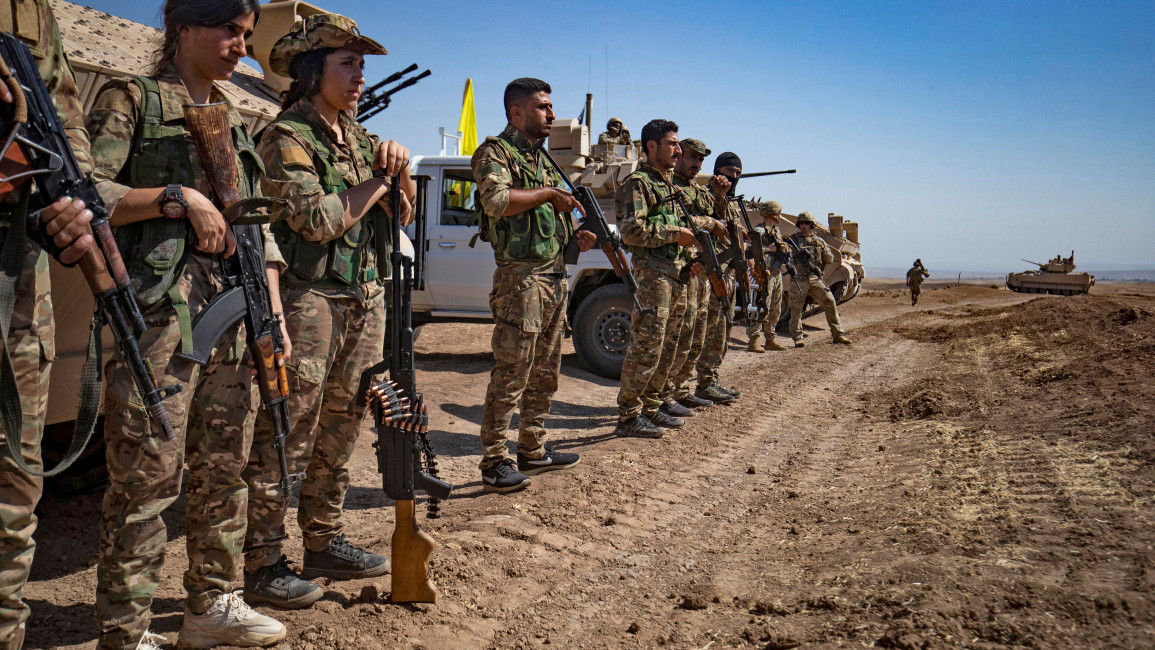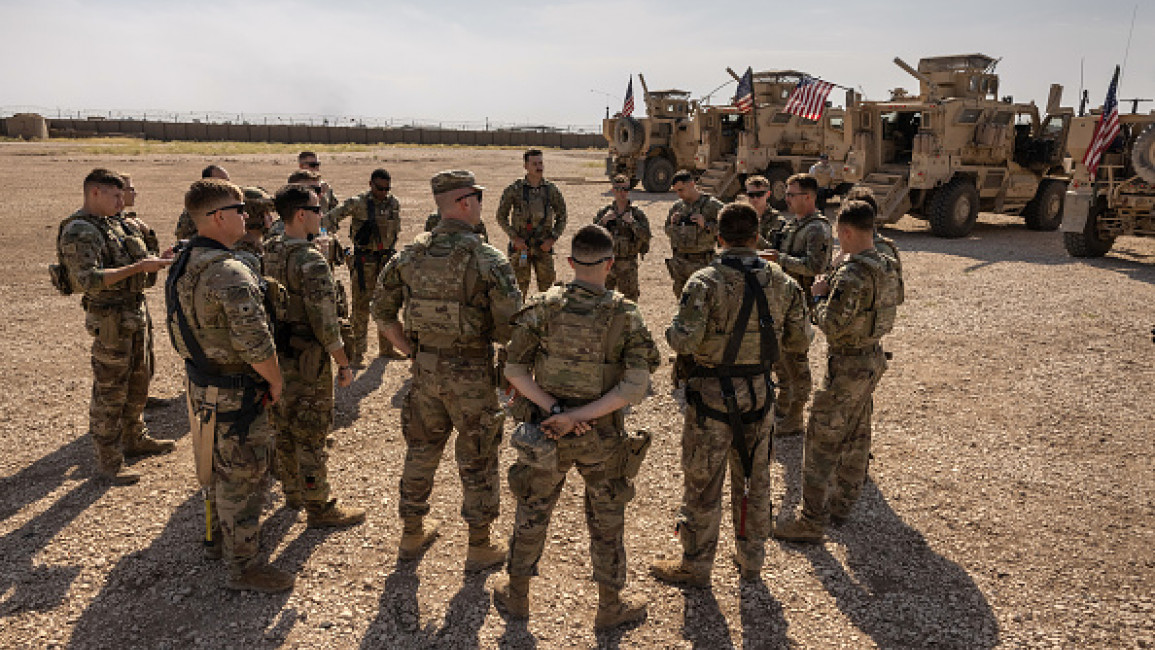Christopher Solomon
Syria, once a Baathist fortress state under the late President Hafez al-Assad, has now become an arena for an array of militias and several foreign militaries, including that of the United States.
Since 2015, US military forces have been present in Syria in support of the Kurdish-led Syrian Democratic Forces’ (SDF) fight against the Islamic State (IS) group.
The US also holds a strategic garrison at the Al-Tanf base in southern Syria, near the Iraqi border. On 15 August, this base was attacked by unidentified drones. In late August, in retaliation, US airstrikes hit targets belonging to Iranian-supported militias near the Syrian city of Deir az-Zour.
The militias were said to be directly supported by Iran’s Revolutionary Guards (IRGC), which have been involved in the Syrian conflict to support the regime of President Bashar al-Assad. The BBC reported that a senior US official said that no Iranian personnel were killed in the US air strikes.
Continuing the anti-terror mission
IS remains active in eastern Syria and has carried out a number of serious attacks. At the start of 2022, IS staged a large-scale prison break and fighting raged for over a week. In July 2022, the group raided an SDF arms dump in Hasakah province.
“The United States is focused on the defeat of IS. Although IS was territorially defeated in Baghuz in Deir az-Zour, there were still daily attacks being carried out by IS in Syria. Also, you have thousands of IS families in the Al Hol camp,” Wladimir van Wilgenburg, co-author of Accidental Allies: The US–Syrian Democratic Forces Partnership Against the Islamic State, told The New Arab.
The SDF’s Anti-Terror Units (YAT) and Asayish forces recently completed an extensive operation to sweep the Al Hol camp, which was aimed at dismantling empty tents and tunnels, freeing people being held captive inside, confiscating weapons, and arresting IS elements inside of the camp.
 Fighters of the Syrian Democratic Forces (SDF) attend a joint military exercise with the US-led coalition against the Islamic State (IS) group in Syria's northeastern Hasakah province on 7 September 2022. [Getty]
Fighters of the Syrian Democratic Forces (SDF) attend a joint military exercise with the US-led coalition against the Islamic State (IS) group in Syria's northeastern Hasakah province on 7 September 2022. [Getty]Supporting the AANES?
In the long run, the US end game regarding their partnership with the SDF is still unclear. Will the US build up a semi-autonomous mini-state like what exists with the Iraqi Kurdistan Regional Government in northern Iraq?
Some would argue that this is what Washington owes the Kurds, who have lost over 11,000 combatants in the fight against IS.
However, this would involve committing political and diplomatic resources to the Kurds. “They don’t have any plan to recognise the Autonomous Administration of North and East Syria (AANES),” said Wilgenburg.
The US is “focused on the UN Resolution to get a political transition in Syria but there is no transitional government in Syria so it is unlikely the US will leave but this depends on what US administration comes next. The Biden Administration wants to stay in Syria. If you get a new Trump Administration it will be different since he wants to leave Syria," he added.
“The US isn’t trying to set up a functioning statelet in [the AANES]. The policy is much less ambitious than that. The Americans are pumping in lots of humanitarian aid, but there’s only some limited political and structural assistance to help the Kurdish leadership govern, and they’re not getting any form of official recognition,” Aron Lund, a fellow with The Century Foundation, explained to The New Arab.
A future US-Iran battleground?
With tensions between the US and Iran still playing out in Iraq, Syria has become a place where the US can retaliate against Iranian-backed proxies without dramatically increasing the stakes in Iraq, where Baghdad is trying to balance friendly relations with both countries.
A future Republican administration could view the US mission in Syria as an opportunity to turn the anti-IS fight into a geopolitical gambit against Iran.
For Iran, the US presence in Syria also gives Tehran a location to strike American targets when they need to shift the scene of the violence to a location outside of Iraq. Kataib Hezbollah, one of the main Iraqi armed groups supported by Iran, allegedly launched the drone attacks on the US Al-Tanf base from Iraq’s Babil Province.
However, the future of Iran in Syria is also uncertain. Russia is pressuring the Iranians to remove their forces from sensitive sites located near Hama and Tartus in an effort to ward off potential Israeli air strikes. If the regime is ever able to regain strength, Damascus might be interested in removing any strong Iranian presence in the long term.
"If the United States is not prepared to recognise the AANES and build up a mini-state, another option would be to facilitate a reconciliation between the Syrian Kurds and the central government in Damascus"
“Damascus and Tehran appear to be turning up the heat on the SDF and its backers as best they can, without getting into serious armed confrontations. But it’s not a straightforward, head-on conflict. They maintain some pragmatic collaboration with the SDF even as they try to weaken, demoralise, and hurt it,” Lund explained.
With the US focused on Russia’s war in Ukraine, Washington is also wary about further antagonising Turkey by granting the SDF any kind of special status.
Concerns about Turkish military activity against the SDF have been growing in recent months. Observers have been watching to see if Turkey’s president, Recep Tayyip Erdogan, will launch a new assault against the SDF in northern Syria in order to establish his desired “buffer zone” against the Kurdistan Workers’ Party militants.
“The Syrian government doesn’t want the SDF to be replaced by Turkish troops, for example, and they need to be careful not to create crises they can’t solve. All actors involved are forced to move incrementally and improvise,” said Lund.
With this in mind, it is possible that Assad will pursue restoring ties with Ankara while also using the SDF to a certain degree to keep Turkish-backed rebels at bay.
 US Army soldiers prepare to go out on patrol from a remote combat outpost in northeastern Syria on 25 May 2021. [Getty]
US Army soldiers prepare to go out on patrol from a remote combat outpost in northeastern Syria on 25 May 2021. [Getty]Mending the Assad regime-SDF rift?
In July, the SDF marked the 10th anniversary of what it refers to as the Rojava Revolution. If the United States is not prepared to recognise the AANES and build up a mini-state, another option would be for Washington to facilitate a reconciliation between the Syrian Kurds and the central government in Damascus.
“I don’t think the Biden Administration has much of a problem with SDF-Damascus talks. There may be certain red lines and they may not want to be too public about it, but in general, I think they see those talks as low-risk and potentially positive,” Lund told The New Arab.
“If the United States is ever to leave Syria, the SDF has to figure out a new modus vivendi with Assad’s regime. They can’t do that without talking to it,” he added.
Tensions occasionally emerge between the SDF and the Syrian regime. In April, the SDF’s fighters took control of several areas of Qamishli, where the government still has a minor presence and holds the airport outside the city.
This occurred when the regime put the Kurdish neighbourhood of Sheikh Maqsoud under siege in the city of Aleppo. The neighbourhood, where the SDF has a small presence, was reportedly blocked off a second time in late August.
However, throughout the Syrian conflict, the AANES has retained a certain level of cooperation with the regime. Lund explained that the SDF’s territory was “structurally entangled with the Syrian state, and it doesn’t have the requisite institutions, economy, local know-how, or foreign backing to break out and be totally independent”.
However, it is still possible for the US to proceed with better positioning the AANES for negotiations and joint-governance with the regime, even if the Syrian conflict remains unresolved. Lund noted that there was more that could be done to help the two sides “coexist peacefully and allow Syrians under their control to rebuild their lives”.
He also noted that, if future SDF-Damascus talks were ever to get to a point where the SDF and the regime decided to unify their areas, the United States would need to leave Syria.
However, Lund said that although this seems very unlikely at the moment, some on the US side might welcome such a deal: “How else would the United States ever be able to extricate itself from Syria?”
No comments:
Post a Comment